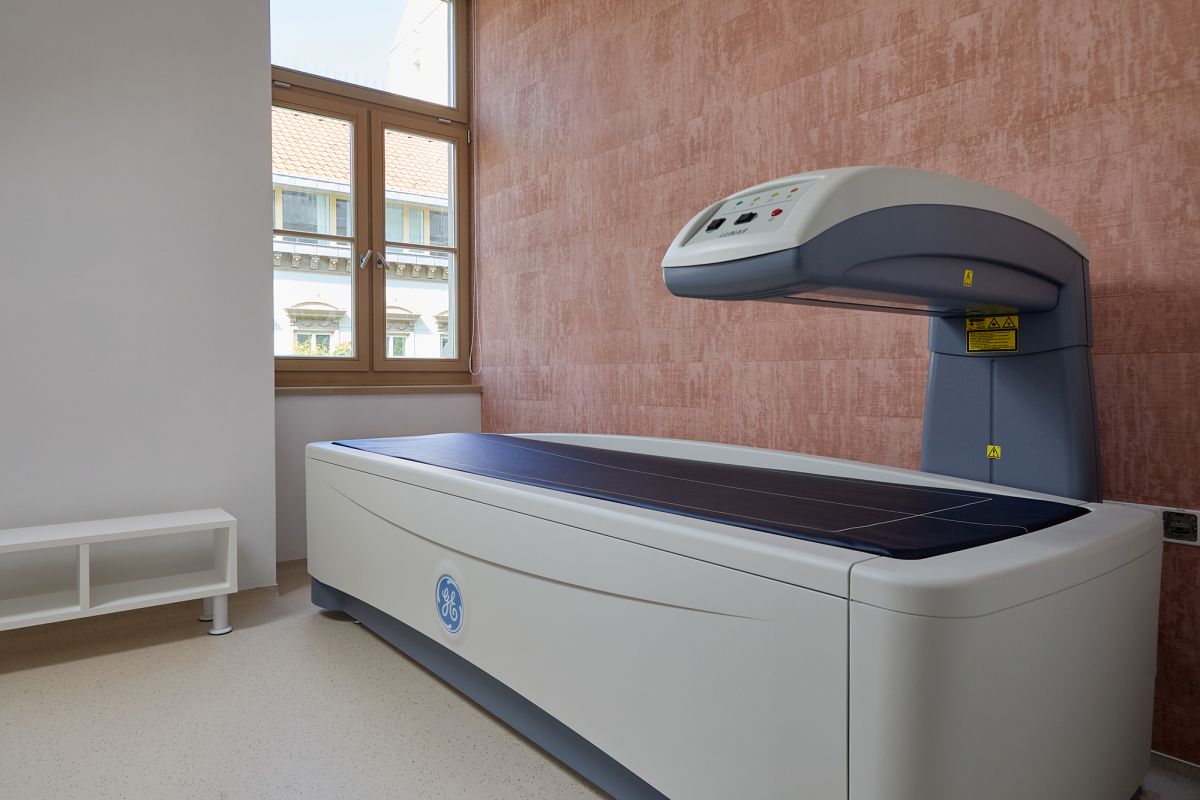The GE Medical Systems LUNAR Prodigy Pro bone density measuring device is one of the most advanced in its category. In addition to measuring bone density, this device is capable of body composition analysis, detecting the distribution of fat tissue and muscle mass by body regions. It provides very precise and clinical-level results.
Bone Density Measurement, ODM
Osteoporosis is a metabolic disease in which bone mass and density decrease and bone structure weakens, increasing brittleness.
Bone density measurement, or osteodensitometry (ODM), measures the mineral content of bones and determines bone density. The procedure uses X-rays, but the radiation dose is low compared to conventional X-ray exams.
About one million people over age 50 in Hungary suffer from osteoporosis. Experts estimate that half of women and a quarter of men over 50 have osteoporosis.
Studies show that one-third of adults over 50 without osteoporosis have reduced bone density (osteopenia), an early stage that can lead to osteoporosis if untreated.
Causes of osteoporosis include aging, which reduces bones’ regenerative ability. Bones are living tissues that continually renew themselves. Until about age 30, the body builds more bone than it breaks down. After age 35, bone loss outpaces replacement, leading to gradual bone mass loss. In osteoporosis, this process accelerates.
Risk factors for osteoporosis:
- Postmenopausal women
- Hyperthyroidism
- Gastrointestinal diseases (celiac disease, inflammatory bowel disease)
- Autoimmune diseases
- Hematologic disorders
- Chronic liver or kidney disease
Women are much more affected due to hormonal changes at menopause. Other risk factors include low calcium intake, low body weight, smoking, and sedentary lifestyle.
Screening every three years is recommended for people over 50 and to monitor therapy effectiveness.
Symptoms:
Osteoporosis usually has no symptoms until a sudden bone fracture occurs, often after minor falls or injuries that would not normally cause fractures. Some warning signs include:
- Height loss
- Changes in posture (more stooped or bent forward)
- Shortness of breath (if spinal discs compress lungs)
- Lower back pain
Contraindications:
- Pregnancy
- Implants in the measurement area (e.g., hip prosthesis, spinal metal implants)
- Recent contrast agents within 48 hours affecting results
- Breastfeeding requires weighing benefits; avoid nursing for 24–48 hours post-test
Procedure:
No special preparation needed, but do not take calcium supplements on test day. Remove jewelry and metal items. The patient lies on an examination table or sits for wrist measurements. The device emits low-dose X-rays at two energies. The hip and lumbar spine are typically measured to detect osteoporosis. The test takes 5–15 minutes.
Results:
Provided immediately as T-score and Z-score.
- T-score compares bone density to healthy young adults; a score below -2.5 indicates osteoporosis.
- Z-score compares to peers of same age, sex, and body type, used mainly for younger people or men.
Whole Body Composition Analysis
This diagnostic test measures the percentages of fat (body fat %), muscle (muscle mass), bone (bone mass), water (body water %), and other components. It is useful for weight loss, training programs, or health assessments and is more accurate than BMI.
Method:
DEXA (Dual-energy X-ray absorptiometry)
The same machine that measures bone density can analyze whole body composition. It provides highly precise clinical results, including regional fat and muscle mass distribution.
Dr. Gulácsy György
Radiologist

